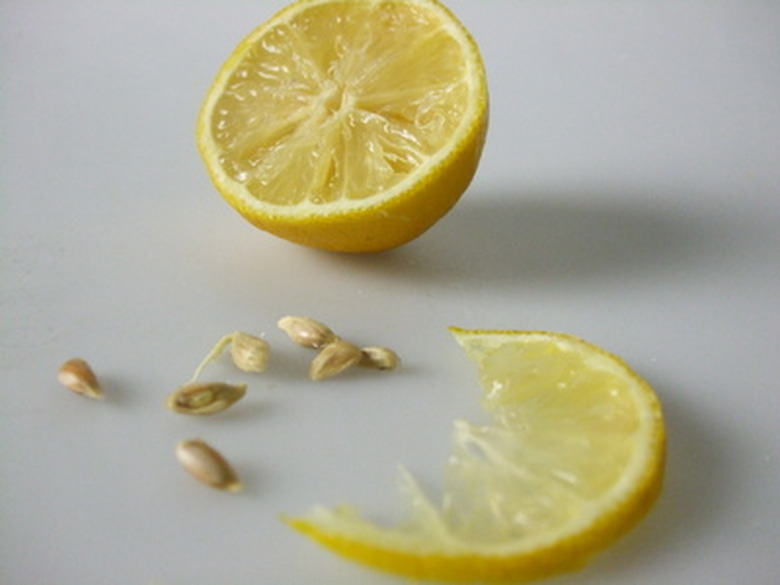Facts About Lemon Seeds
Lemon seeds are usually considered an afterthought, if that, when it comes to the actual fruit they are contained in. Plump, bright and flavorful, lemons serve as the stars in many beverages and meals. But the tiny seeds are ultimately responsible for all of those flavorful tarts, cold summer drinks and seafood toppers. The seeds traveled far to reach America. Many lemon varieties are now grown in orchards and home gardens alike.
Structure
Lemon seeds nestle within the pulp near the center of each fruit. Their numbers and size vary according to variety, but most are hard, wrinkled, white, elliptical or oval and measure about 3/8 inch long. "Rough" lemons with sturdier rinds are usually grown from seed. Some hybrids are grafted onto root stocks or grown from large cuttings.
- Lemon seeds are usually considered an afterthought, if that, when it comes to the actual fruit they are contained in.
- Rough" lemons with sturdier rinds are usually grown from seed.
History
No one really knows where lemons originated, according to Purdue University's department of horticulture, but they have been tied to northwestern India. They are thought to have appeared in southern India in 200 A.D. and spread south and east from there. Christopher Columbus is credited with bringing lemons to Hispaniola in 1493, and the Spanish then probably introduced them to Saint Augustine, Florida along with oranges and other citrus. Florida and California began commercially growing them in the 1830s, but competition, hard freezes and disease in Florida in the latter part of the century scaled back production there. Lemon trees are more sensitive to cold snaps than oranges because their growth is more constant.
Varieties
Lemon varieties grown today are primarily the result of horticulturalists weeding out weaker plant varieties in search of vigorous, hardy producers after the Florida freezes. Not all fruit has seeds, nor do they even have a yellow hue. For instance, Armstrong is a seedless variety while Meyer is a mandarin hybrid with light orange, sweet tasting fruit.
- No one really knows where lemons originated, according to Purdue University's department of horticulture, but they have been tied to northwestern India.
Consumption
The oil from seeds is extracted and used for various medicinal purposes, from digestive detoxification to acne treatments, none of which have been scientifically proven to work. The ASPCA states if animals or people consume seeds in large quantities, they could cause "irritation and possibly even nervous system depression," but if eaten in small amounts or accidentally, will most likely cause nothing more than stomach upset.
Growing
Lemon trees can be grown from the seeds in the fruit that you eat, as long as they are planted immediately, according to New Mexico State University Cooperative Extension Service. Wash them to remove sugar clinging to the seed coat. Do not allow the seeds to dry. Plant the moist seeds in potting soil about ½ inch deep, then cover the top of the pot with plastic wrap to create a greenhouse effect. Place in warm location, and in the sun when the seeds sprout. Unless you graft seedlings to a mature lemon tree, you will have to wait 15 years for lemons to grow. Grafting will reduce the wait by about 5 years.
- The oil from seeds is extracted and used for various medicinal purposes, from digestive detoxification to acne treatments, none of which have been scientifically proven to work.
- Plant the moist seeds in potting soil about ½ inch deep, then cover the top of the pot with plastic wrap to create a greenhouse effect.
